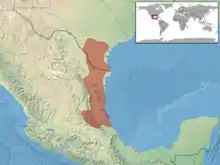Ficimia streckeri
Ficimia streckeri, also commonly known as the Mexican hooknose snake, the Tamaulipan hooknose snake, and the Texas hook-nosed snake, is a small species of snake in the family Colubridae. The species is native to northeastern Mexico and adjacent southern Texas.
| Ficimia streckeri | |
|---|---|
| Scientific classification | |
| Kingdom: | Animalia |
| Phylum: | Chordata |
| Class: | Reptilia |
| Order: | Squamata |
| Suborder: | Serpentes |
| Family: | Colubridae |
| Genus: | Ficimia |
| Species: | F. streckeri |
| Binomial name | |
| Ficimia streckeri Taylor, 1931 | |
 | |
Etymology
The specific name or epithet, streckeri, is in honor of the American naturalist John Kern Strecker Jr.[2][3]
Geographic range
F. streckeri is found primarily in the Mexican states of Hidalgo, Nuevo León, Puebla, eastern San Luis Potosí, and Tamaulipas, but its geographic range extends as far north as southern Texas in the United States.[4]
Description
The Mexican hooknose snake is usually 5 to 11 in (13 to 28 cm) in total length (including tail). H.M. Smith and Brodie (1982) report a maximum total length of 47.9 cm (almost 19 inches).[5]
It is typically brown or gray in color, with as many as 60 brown or brown-green blotches down the back, which are elongated to almost appear as stripes. Its underside is white or cream-colored.
Its most distinctive feature is an upturned snout, much like hognose snakes, which gives it its common name. However, unlike hognose snakes, Mexican hooknose snakes have smooth dorsal scales. Also distinctive is the arrangement of the head shields. There are no internasals, and the rostral separates the prefrontals and contacts the frontal.[6]
The smooth dorsal scales are arranged in 17 rows at midbody. Ventrals 126-155, subcaudals 28-41.[5]
Behavior
The Mexican hooknose snake is mostly nocturnal, and is a burrower.[7][8] It is fairly slow-moving and harmless to humans.
Diet
The diet of F. streckeri consists primarily of spiders and centipedes.[9]
Habitat
The Mexican hooknose snake inhabits woodlands along the Rio Grande river plain, near natural and man-made sources of water.[10]
Defense
The primary form of defense of F. streckeri is making a popping sound by expanding its cloaca when harassed or handled.[6]
References
- Hammerson GA, Lavin P, Mendoza Quijano F (2007). "Ficimia streckeri ". The IUCN Red List of Threatened Species 2007: e.T63784A12708575. https://dx.doi.org/10.2305/IUCN.UK.2007.RLTS.T63784A12708575.en. Downloadedon 16 July 2020.
- Beltz, Ellin (2006). Scientific and Common Names of the Reptiles and Amphibians of North America - Explained. www.ebeltz.net/herps/biogappx.html#S.
- Beolens, Bo; Watkins, Michael; Grayson, Michael (2011). The Eponym Dictionary of Reptiles. Baltimore: Johns Hopkins University Press. xiii + 296 pp. ISBN 978-1-4214-0135-5. (Ficimia streckeri, p. 256).
- Species Ficimia streckeri at The Reptile Database www.reptile-database.org.
- Smith HM, Brodie ED Jr (1982). Reptiles of North America: A Guide to Field Identification. New York: Golden Press. 240 pp. ISBN 0-307-13666-3. (Ficimia streckeri, pp. 174-175).
- Schmidt KP, Davis DD (1941). Field Book of Snakes of the United States and Canada. New York: G.P. Putnam's Sons. 365 pp. (Ficimia streckeri, p. 203).
- Wright AH, Wright AA (1957). Handbook of Snakes of the United States and Canada. Ithaca and London: Comstock. 1,105 pp. (in 2 volumes) (Ficimia olivacea streckeri, pp. 279-282, Figure 86, Map 26).
- Conant R (1975). A Field Guide to Reptiles and Amphibians of Eastern and Central North America, Second Edition. The Peterson Field Guide Series. Boston: Houghton Mifflin. 429 pp. (Ficimia streckeri, pp. 216-217 + Plate 33 + Map 160).
- Behler JL, King FW (1979). The Audubon Society Field Guide to North American Reptiles and Amphibians. New York: Alfred A. Knopf. 743 pp., 657 color plates. ISBN 0-394-50824-6. (Ficimia streckeri, pp. 611–612 + Plate 547).
- Powell R, Conant R, Collins JT(2016). Peterson Field Guide to Reptiles and Amphibians of Eastern and Central North America, Fourth Edition. Boston and New York: Houghton Mifflin Harcourt. xiv + 494 pp. 47 color plates, 207 Figures. ISBN 978-0-544-12997-9. (Ficimia streckeri, pp. 374–375 + Plate 33).
External links
- Herps of Texas: Ficimia streckeri
 Media related to Ficimia streckeri at Wikimedia Commons
Media related to Ficimia streckeri at Wikimedia Commons Data related to Ficimia streckeri at Wikispecies
Data related to Ficimia streckeri at Wikispecies
Further reading
- Axtell RW (1950). "Two Specimens of the Snake Ficimia streckeri from Texas". Copeia 1950 (2): 157.
- Goldberg SR (2016). "Notes on the Testicular Cycle of the Mexican Hooknose Snake, Ficimia streckeri (Serpentes, Colubridae)". Sonoran Herpetologist 29 (4): 48.
- Heimes P (2016). Snakes of Mexico: Herpetofauna Mexicana Vol. I. Frankfurt am Main, Germany: Chimaira. 572 pp. ISBN 978-3899731002.
- Taylor EH (1931). "Notes on Two Specimens of the Rare Snake Ficimia cana and the Description of a New Species of Ficimia from Texas". Copeia 1931 (1): 4-7. (Ficimia streckeri, new species).
- Zim HS, Smith HM (1956). Reptiles and Amphibians: A Guide to Familiar American Species. Revised Edition. Golden Nature Guides Series. New York: Simon and Schuster. 160 pp. (Ficimia streckeri, pp. 83–84, 156).
